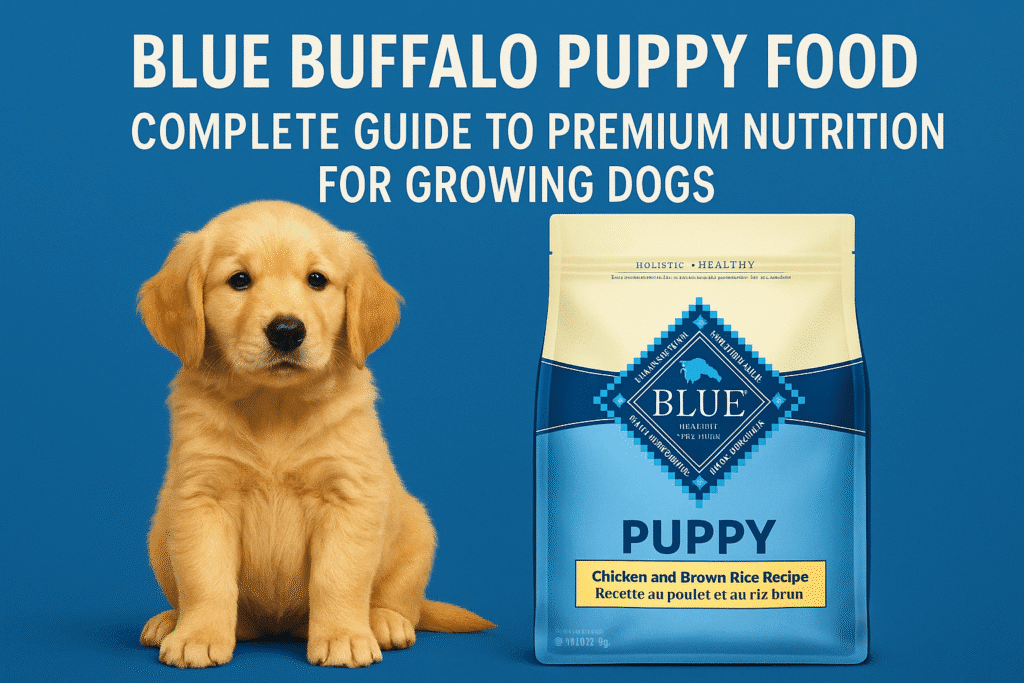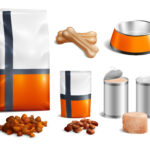Choosing the right puppy food feels overwhelming when you’re staring at endless rows of colorful bags at the pet store. I remember spending nearly an hour reading labels when I first brought my golden retriever puppy home, completely confused by ingredient lists and marketing claims. Blue Buffalo has become one of the most recognizable premium puppy food brands, but what actually sets it apart from the dozens of other options?
After years of feeding different dogs and countless conversations with veterinarians, I’ve learned that not all puppy foods are created equal. Blue Buffalo positions itself as a natural, high-quality option, but understanding whether it’s right for your puppy requires looking beyond the marketing and into the actual ingredients, nutrition, and practical considerations that matter most during those crucial first months of growth.


What Makes Blue Buffalo Puppy Food Different from Other Brands
Natural Ingredients and Real Meat as First Ingredient
Blue Buffalo built its reputation on putting real meat as the first ingredient in every formula. Walk down any pet food aisle and you’ll notice many brands list corn, wheat, or meat by-products first – but Blue Buffalo consistently features deboned chicken, lamb, or salmon at the top of their ingredient lists.
The difference becomes clear when you compare a typical budget puppy food to Blue Buffalo. While cheaper options might use “chicken meal” or “poultry by-product meal,” Blue Buffalo uses actual deboned chicken. This means your puppy gets recognizable protein sources rather than rendered parts you wouldn’t want to think about too deeply.
Beyond the protein sources, Blue Buffalo eliminates artificial preservatives, colors, and flavors that serve no nutritional purpose for growing puppies. Instead of chemical preservatives like BHA or BHT, they use natural preservation methods with mixed tocopherols (vitamin E). I appreciate this approach because puppies already have sensitive digestive systems – why add unnecessary artificial ingredients?
The inclusion of whole grains, vegetables, and fruits creates a more balanced nutritional profile. You’ll find ingredients like sweet potatoes, blueberries, and carrots that provide natural vitamins and antioxidants. These whole food ingredients cost more than synthetic alternatives, which explains part of Blue Buffalo’s higher price point.
LifeSource Bits Technology and Antioxidant Blend
One unique feature you’ll notice when opening a bag of Blue Buffalo is the dark-colored kibble bits mixed in with the regular food. These “LifeSource Bits” represent Blue Buffalo’s attempt to add targeted nutrition through cold-formed kibble containing concentrated vitamins, minerals, and antioxidants.
The cold-forming process preserves heat-sensitive nutrients that might be destroyed during regular kibble manufacturing. Think of it like the difference between fresh vegetables and canned ones – the cold-formed bits retain more of their original nutritional value.
These bits contain ingredients specifically chosen for immune system support, including vitamin C, vitamin E, and beta-carotene. For growing puppies, immune system support matters tremendously since they’re still developing their natural defenses and encountering new environments, people, and potential pathogens.
The veterinarian-developed formula aspect gives me more confidence than brands that seem to prioritize marketing over nutrition science. Blue Buffalo works with veterinary nutritionists to create formulas that support optimal puppy development rather than just meeting minimum requirements.
No Chicken By-Product Meals or Corn Gluten Meal
Blue Buffalo’s “no by-product meals” stance addresses one of the most controversial ingredients in dog food. Chicken by-product meal can include necks, feet, intestines, and other parts that technically provide protein but aren’t what most pet owners envision when they think about feeding their puppy.
The elimination of corn gluten meal also matters for protein quality. Corn gluten meal serves as a cheap protein source that helps manufacturers boost protein percentages on paper, but it doesn’t provide the complete amino acid profile that growing puppies need from animal proteins.
This focus on whole food ingredients rather than processed alternatives costs more but potentially provides better nutrition. Instead of corn gluten meal, Blue Buffalo uses ingredients like fish meal, chicken meal (from actual chicken meat), and egg products for additional protein sources.
The clear ingredient labeling and transparency in sourcing helps pet owners make informed decisions. Blue Buffalo provides detailed information about where ingredients come from and why they’re included, which builds trust compared to brands with vague ingredient descriptions.
Nutritional Analysis and Benefits for Growing Puppies
Protein Content and Essential Amino Acids
Growing puppies need significantly more protein than adult dogs – typically 22-25% minimum compared to 18% for adults. Blue Buffalo puppy formulas consistently exceed these minimums, usually providing 26-32% protein depending on the specific recipe.
More important than total protein percentage is the amino acid profile. Puppies need all ten essential amino acids in proper proportions for healthy muscle development, organ function, and overall growth. Animal proteins like chicken, lamb, and salmon provide complete amino acid profiles that plant proteins alone cannot match.
Blue Buffalo formulates different protein levels for different breed sizes. Small breed puppies get higher protein concentrations to support their faster metabolisms, while large breed formulas are carefully balanced to prevent too-rapid growth that can cause skeletal problems.
The quality of protein sources affects digestibility too. My experience with different brands has shown that puppies tend to have firmer stools and better energy levels on high-quality animal proteins compared to foods with significant plant protein content.
Calcium and Phosphorus Balance for Bone Development
Calcium and phosphorus balance represents one of the most critical nutritional factors for growing puppies, especially large breeds. Too much calcium can cause skeletal deformities, while too little prevents proper bone development.
Blue Buffalo maintains calcium-to-phosphorus ratios between 1.2:1 and 1.4:1, which falls within veterinary recommendations for healthy bone formation. Large breed puppy formulas typically contain 1.0-1.8% calcium on a dry matter basis, carefully controlled to prevent developmental orthopedic disease.
The inclusion of DHA from fish oil supports brain and eye development during crucial puppy growth phases. DHA (docosahexaenoic acid) is the same omega-3 fatty acid recommended for human infants, and research shows it supports cognitive development in puppies too.
Proper mineral balance extends beyond just calcium and phosphorus. Blue Buffalo includes chelated minerals that absorb more easily than standard mineral forms, improving overall nutritional utilization.
Digestive Health and Fiber Content
Puppy digestive systems are notoriously sensitive, and Blue Buffalo addresses this with prebiotic fiber sources that support beneficial gut bacteria. Ingredients like chicory root provide inulin, a prebiotic fiber that feeds good bacteria in the intestinal tract.
The fiber content stays within optimal ranges – typically 3-5% crude fiber – that promote regular bowel movements without causing loose stools. Too much fiber can interfere with nutrient absorption, while too little can cause digestive issues.
Easy-to-digest ingredients reduce the likelihood of stomach upset during the critical puppy months when digestive systems are still maturing. Blue Buffalo avoids common digestive irritants while including ingredients like oatmeal and brown rice that most puppies tolerate well.
Blue Buffalo Puppy Food Product Lines and Varieties
Life Protection Formula for Puppies
The Life Protection Formula represents Blue Buffalo’s mainstream puppy food line, designed for most puppies without special dietary needs. The chicken and brown rice recipe provides balanced nutrition with familiar ingredients that most dogs tolerate well.
For puppies with chicken sensitivities, the lamb and oatmeal option offers an alternative protein source while maintaining the same nutritional standards. Lamb tends to be easier to digest for sensitive puppies, though it costs more than chicken-based formulas.
The fish and sweet potato varieties deliver high omega-3 fatty acid content from salmon, supporting coat health and brain development. Fish-based formulas work well for puppies with food allergies, though the stronger smell might be less appealing to some pet owners.
All Life Protection formulas include the LifeSource Bits and maintain consistent nutritional profiles across protein sources, making transitions between varieties easier if needed.
Wilderness High Protein Grain-Free Options
Blue Buffalo Wilderness targets pet owners who prefer grain-free diets inspired by ancestral canine nutrition. These formulas contain 32-38% protein, significantly higher than traditional puppy foods.
The grain-free recipes substitute sweet potatoes and peas for traditional grains like rice and oats. Some puppies digest these alternatives better, though grain-free diets have faced scrutiny recently regarding potential links to heart disease in some dogs.
Multiple protein options include salmon, chicken, and turkey, allowing owners to rotate proteins or find options that work best for their individual puppy. The high protein content supports active, growing puppies but might be too rich for less active dogs.
I personally have mixed feelings about grain-free diets for puppies. While some dogs thrive on them, the potential heart disease connection makes me cautious about recommending them without specific medical reasons.
Basics Limited Ingredient Diet for Sensitive Puppies
For puppies with food sensitivities or allergies, Blue Buffalo Basics offers simplified nutrition with single animal protein sources and limited ingredient lists. These formulas typically contain 8-10 ingredients compared to 30+ in regular formulas.
The single protein source approach makes it easier to identify and avoid allergens. If your puppy develops digestive issues or skin problems, limited ingredient diets help eliminate potential triggers systematically.
Simplified nutrition doesn’t mean compromised nutrition – these formulas still meet all AAFCO requirements for puppy growth. However, they cost more per pound due to specialized manufacturing and limited ingredient sourcing.
Feeding Guidelines and Portion Control by Puppy Size
Small Breed Puppy Feeding Requirements (Under 25 pounds)
Small breed puppies have faster metabolisms and higher energy needs per pound of body weight compared to larger breeds. Blue Buffalo small breed formulas contain higher calorie density – typically 380-400 calories per cup compared to 350-370 for regular formulas.
The smaller kibble size accommodates tiny mouths and makes eating easier for breeds like Chihuahuas, Yorkshire Terriers, and Maltese. Standard-sized kibble can be difficult or impossible for very small puppies to chew properly.
Small breed puppies need more frequent feeding – typically 3-4 times daily through 6 months of age, then twice daily. Their small stomachs can’t hold enough food for once-daily feeding, and they’re prone to hypoglycemia if they go too long between meals.
Large Breed Puppy Considerations (Over 50 pounds adult weight)
Large breed puppies require careful nutritional management to prevent skeletal problems caused by too-rapid growth. Blue Buffalo large breed formulas contain controlled calcium levels – typically 1.0-1.5% compared to up to 1.8% in regular puppy food.
Lower calorie density supports steady, controlled growth rather than maximum growth rate. Large breed puppies should gain weight gradually to allow proper bone and joint development.
The feeding period extends longer for large breeds – typically 18-24 months compared to 12-15 months for smaller dogs. Giant breeds like Great Danes might benefit from puppy food until 24 months or longer.
Transition Schedules and Age-Based Feeding Charts
Gradual food transitions over 7-10 days prevent digestive upset when switching to Blue Buffalo from another brand. Start with 25% Blue Buffalo mixed with 75% old food for 2-3 days, then progress to 50/50, then 75/25, and finally 100% Blue Buffalo.
Weekly portion adjustments based on puppy weight and body condition ensure proper nutrition without overfeeding. Puppies should have visible waist tucks and ribs that are easily felt but not visible.
The transition from puppy to adult food depends on breed size and individual development. Most dogs switch between 12-18 months, but large breeds often need puppy nutrition longer to support their extended growth periods.
Cost Analysis and Value Comparison with Competitors
Price Per Pound and Cost Per Feeding
Blue Buffalo puppy food typically costs $2.50-$4.00 per pound depending on the formula and bag size. Larger bags provide better per-pound value, but only buy sizes you can use within 6 weeks of opening to maintain freshness.
Daily feeding costs vary significantly by puppy size. A 10-pound puppy might cost $0.75-$1.00 daily to feed, while a 60-pound puppy could cost $2.50-$3.50 daily. These calculations help budget for the reality of premium dog food costs.
Long-term value assessment should consider potential health benefits from quality nutrition during crucial development periods. Better nutrition during puppyhood might prevent expensive health problems later, though this is difficult to quantify precisely.
Comparison with Premium and Budget Puppy Food Brands
Compared to budget brands costing $1.00-$1.50 per pound, Blue Buffalo costs 2-3 times more but provides significantly higher ingredient quality. Budget foods often use corn, wheat, and by-products as primary ingredients.
Against other premium brands like Hill’s Science Diet, Royal Canin, or Wellness, Blue Buffalo falls in the middle price range while offering competitive nutritional profiles. Some veterinary brands cost more but may provide more specialized nutrition research.
Performance comparisons with similar premium brands show Blue Buffalo holds its own in terms of palatability, digestibility, and overall nutrition. Personal preference often drives choices between premium brands since they’re generally all nutritionally adequate.
Where to Buy and Money-Saving Opportunities
Blue Buffalo is widely available in pet stores, farm stores, and online retailers like Chewy or Amazon. Online purchasing often provides the best prices, especially with subscription services offering 5-15% discounts.
Bulk purchasing larger bags reduces per-pound costs, but only makes sense if you can use the food before it becomes stale. Dry puppy food stays fresh for about 6 weeks after opening when stored properly.
Manufacturer coupons and promotional offers can reduce costs by $3-$5 per bag occasionally. Pet stores sometimes price-match online retailers, making local purchase more affordable while supporting local businesses.
conclusion
Blue Buffalo puppy food offers a premium nutrition option for growing dogs, emphasizing natural ingredients, real meat proteins, and scientifically formulated nutrition. The brand provides multiple product lines to accommodate different dietary needs, from traditional recipes to grain-free and limited ingredient options. While the cost is higher than budget alternatives, the focus on quality ingredients and puppy-specific nutrition makes it a worthwhile investment for many dog owners. Proper feeding guidelines, gradual transitions, and attention to individual puppy needs are essential for maximizing the benefits of this premium puppy food.
Frequently Asked Questions
Q: At what age should I switch my puppy from Blue Buffalo puppy food to adult food?
A: Most puppies should transition to adult food between 12-18 months, though large breed puppies may benefit from puppy food until 18-24 months of age.
Q: Can Blue Buffalo puppy food cause loose stools in some puppies?
A: Any diet change can cause temporary digestive upset. Gradual transition over 7-10 days and choosing the appropriate formula for your puppy’s sensitivities can minimize this issue.
Q: Is Blue Buffalo puppy food suitable for all breed sizes?
A: Yes, Blue Buffalo offers formulas specifically designed for small breeds, large breeds, and all life stages, with appropriate kibble sizes and nutritional profiles for each.
Q: How does Blue Buffalo puppy food compare nutritionally to raw diets?
A: Blue Buffalo provides complete and balanced nutrition that meets AAFCO standards, while raw diets require careful planning to avoid nutritional imbalances and food safety risks.
Q: Should I mix wet and dry Blue Buffalo puppy food together?
A: Mixing wet and dry food is acceptable and can increase palatability, but adjust total portions to prevent overfeeding and maintain proper nutritional balance.



